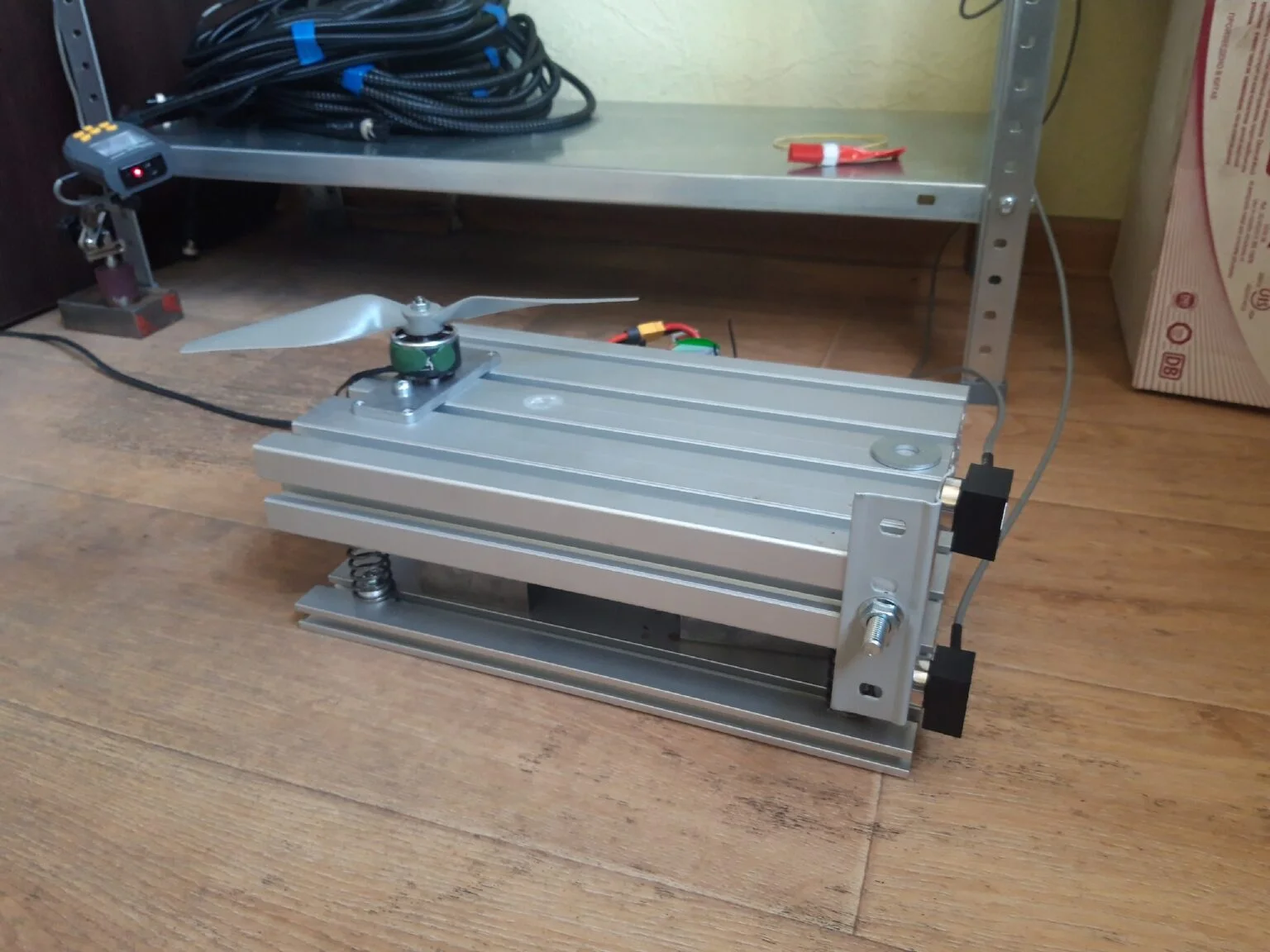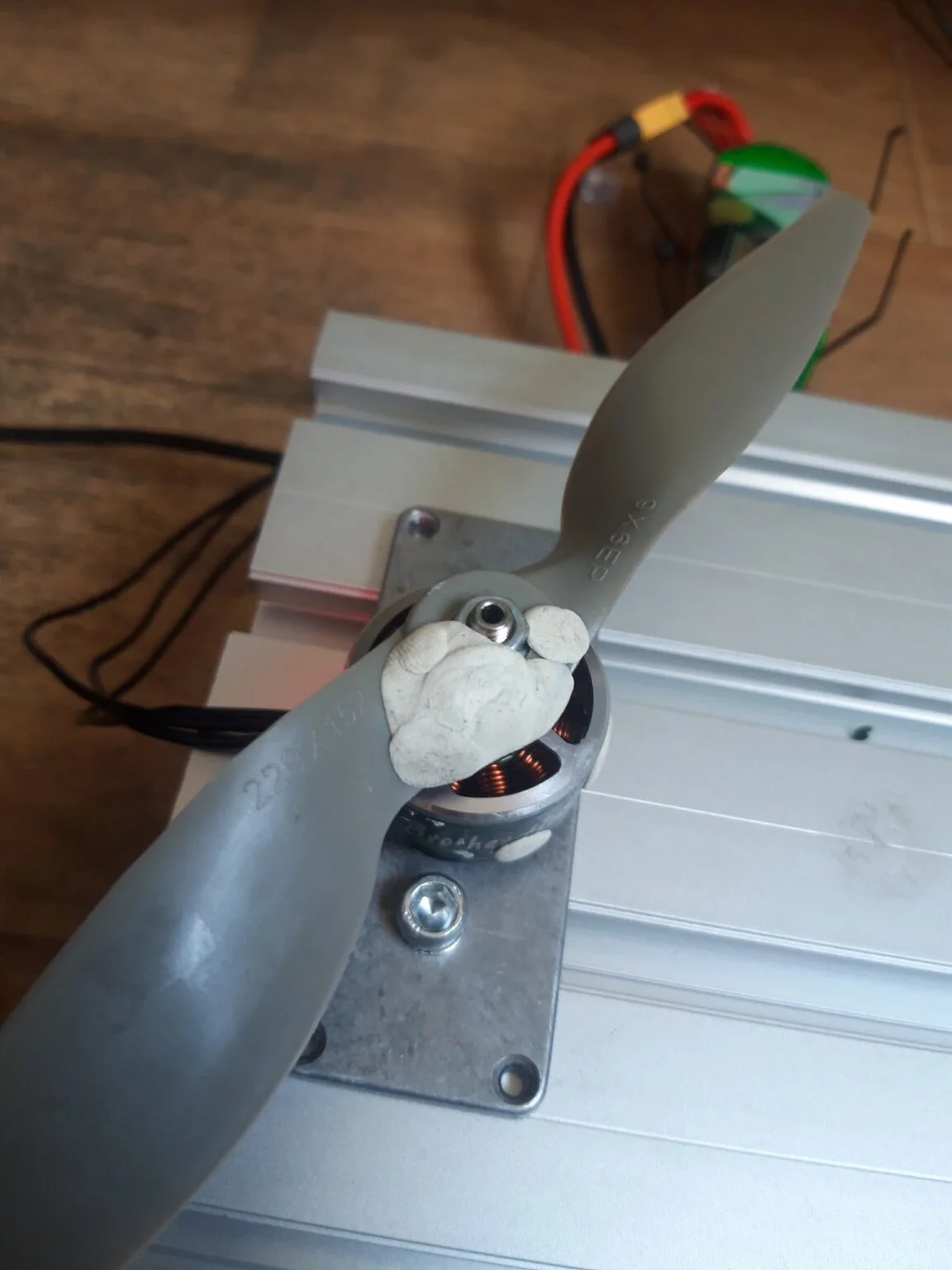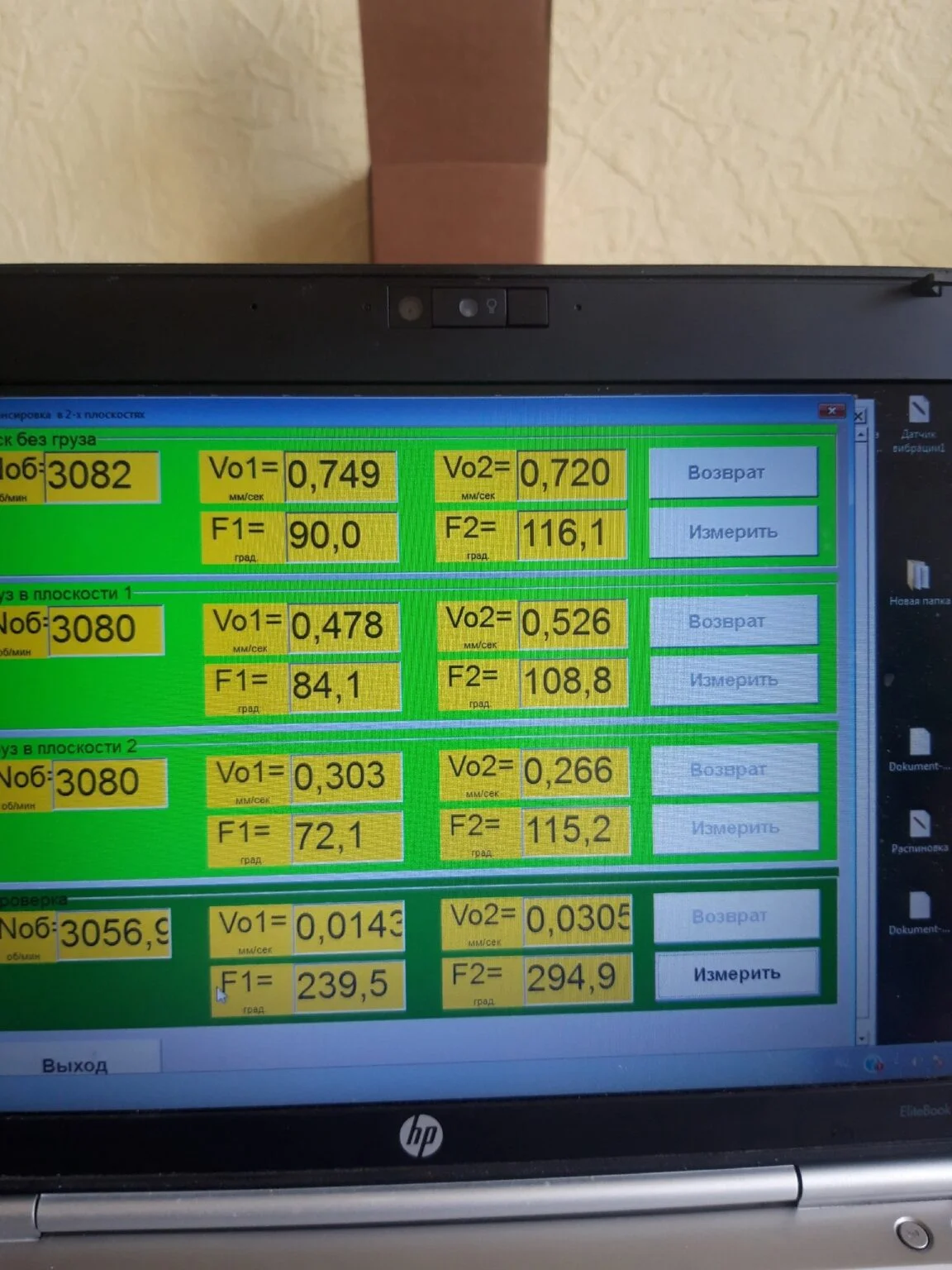การปรับสมดุลแบบไดนามิกของใบพัดโดรน
เพิ่มประสิทธิภาพการทำงานของควอดคอปเตอร์ด้วยการปรับสมดุลใบพัดอย่างแม่นยำเพื่อประสิทธิภาพสูงสุดและอายุการใช้งานที่ยาวนาน
📡Introduction
ในขณะที่ควอดคอปเตอร์ หรือที่รู้จักกันทั่วไปในชื่อโดรน ทะยานขึ้นสู่ท้องฟ้าและกลายเป็นเครื่องมือสำคัญในหลากหลายสาขา ตั้งแต่การถ่ายภาพไปจนถึงการเกษตร การทำให้มั่นใจว่าประสิทธิภาพสูงสุดของโดรนจึงเป็นสิ่งสำคัญยิ่ง ปัจจัยสำคัญในการทำงานอย่างมีประสิทธิภาพสูงสุดนี้คือการปรับสมดุลแบบไดนามิกของใบพัด
บทความนี้จะเจาะลึกถึงรายละเอียดปลีกย่อยอันซับซ้อนที่เกี่ยวข้องกับผลกระทบจากการสั่นสะเทือนที่เพิ่มขึ้นและความจำเป็นในการถ่วงดุลใบพัดแบบไดนามิกที่ตามมา เราจะพิจารณารากฐานทางทฤษฎี วิธีแก้ปัญหาในทางปฏิบัติ และตัวอย่างเฉพาะของการใช้เทคโนโลยี Balanset-1A เพื่อให้ได้ผลลัพธ์ที่เหนือกว่า
⚠️Issues Stemming from Elevated Vibrations
1. คุณภาพของภาพที่ลดลง
แม้ว่าภาพที่บันทึกได้จะเกือบสมบูรณ์แบบเมื่อควอดคอปเตอร์ลอยนิ่งอยู่กับที่ แต่การเคลื่อนไหวด้านข้างหรือการปรับระดับความสูงอาจทำให้เกิดความผิดปกติได้ "เอฟเฟกต์เจลลี่" และการสั่นไหวเป็นระยะๆ นี้อาจลดคุณภาพของภาพหรือวิดีโอลงอย่างมาก ทำให้ภาพดูไม่น่าสนใจและเป็นมืออาชีพน้อยลง
2. ความเครียดของมอเตอร์และฮาร์ดแวร์
แรงสั่นสะเทือนซึ่งส่วนใหญ่มาจากมอเตอร์จะเพิ่มขึ้นตามรอบต่อนาที ซึ่งไม่เพียงแต่ส่งผลกระทบต่อกิมบอลหรือระบบกันสะเทือนของกล้องเท่านั้น แต่ยังสร้างความเครียดให้กับกลไกของมอเตอร์อีกด้วย แรงสั่นสะเทือนที่เกิดขึ้นอย่างต่อเนื่องจะเร่งการสึกหรอของมอเตอร์ ลูกปืน และเฟือง ส่งผลให้ต้องเปลี่ยนบ่อยขึ้นและค่าใช้จ่ายในการบำรุงรักษาก็เพิ่มขึ้นด้วย
3. เสียงรบกวนและการสั่นสะเทือนจากใบพัดที่ไม่สมดุล
A notable chunk of off-the-shelf propellers, particularly the budget variants, lack optimal balance. Such propellers not only introduce irritating noise levels but also contribute to the overarching problem of increased vibration. This accentuates the aforementioned issues, making the drone less efficient and more prone to mechanical problems.
✨Benefits of Dynamic Balancing
Dynamic balancing of each propeller, when executed meticulously, offers a plethora of advantages:
1. การลดเสียงรบกวน
A balanced propeller operates quieter, leading to less disturbance in environments where noise can be a concern, such as wildlife photography or residential areas.
2. ประสิทธิภาพทางอากาศพลศาสตร์ที่เพิ่มขึ้น
Balanced propellers promise superior aerodynamic performance. This optimization means that the drone can achieve its objectives with lesser energy consumption.
3. ปรับปรุงเวลาบิน
With improved aerodynamics and reduced energy wastage due to vibrations, drones can stay airborne for longer durations, maximizing the potential of each flight session.
4. ลดการสึกหรอ
การกำจัดต้นตอของแรงสั่นสะเทือนที่มากเกินไปจะช่วยลดแรงกดโดยรวมของส่วนประกอบต่างๆ ของควอดคอปเตอร์ลงได้อย่างมาก ส่งผลให้มอเตอร์ ตลับลูกปืน กิมบอล และส่วนประกอบสำคัญอื่นๆ มีอายุการใช้งานที่ยาวนานขึ้น
5. คุณภาพของภาพที่เหมาะสมที่สุด
การปรับสมดุลแบบไดนามิกช่วยลด "เอฟเฟกต์เจลลี่" และการสั่นไหวที่เกิดขึ้นเป็นระยะๆ ช่วยให้มั่นใจได้ว่าภาพที่บันทึกได้จะมีคุณภาพสูงสุด ปราศจากความผิดปกติใดๆ ที่เกิดจากการสั่นสะเทือน
6. เพิ่มความน่าเชื่อถือของระบบ
ใบพัดที่มีความสมดุลอย่างเหมาะสมจะช่วยลดความเครียดทางกลทั่วทั้งระบบโดรน ส่งผลให้การทำงานมีเสถียรภาพมากขึ้น และลดโอกาสที่อุปกรณ์จะล้มเหลวระหว่างภารกิจที่สำคัญ
🔬ตัวอย่าง
One example is the successful implementation of our บาลานเซ็ต-1A dynamic balancing device by one of our clients for drone propeller balancing tasks.
Our client followed our expert recommendations to construct a dedicated balancing stand for drone propellers. ขาตั้งนี้ผลิตจากโปรไฟล์อลูมิเนียมโครงสร้างและมีตัวแยกการสั่นสะเทือนแบบสปริงเพื่อให้มั่นใจถึงความแข็งแกร่งของโครงสร้างพร้อมลดการรบกวนจากการสั่นสะเทือนจากภายนอกให้น้อยที่สุด
ภาพขาตั้งแบบสมดุล



การวิเคราะห์ผลการวัดโดยละเอียด
ระดับการสั่นสะเทือนเริ่มต้น (ก่อนการปรับสมดุล):
- Vo1 = 0.749 มม./วินาที (เครื่องบิน 1)
- Vo2 = 0.720 มม./วินาที (เครื่องบิน 2)
- ระยะต่างๆ: F1 = 90.0°, F2 = 116.1°
- ความเร็วในการหมุน: ~3082 รอบต่อนาที
ผลลัพธ์สุดท้าย (หลังจากติดตั้งน้ำหนักการแก้ไข):
- Vo1 = 0.0143 มม./วินาที (ลด 98.1%)
- Vo2 = 0.0305 มม./วินาที (ลดลง 95.8%)
- ระยะต่างๆ: F1 = 239.5°, F2 = 294.9°
- ความเร็วในการหมุน: 3056.6 รอบต่อนาที
บทสรุป:
การปรับสมดุลเสร็จสมบูรณ์: ระดับการสั่นสะเทือนในทั้งสองระนาบลดลงอย่างมีนัยสำคัญเหลือต่ำกว่า 0.03 มม./วินาที ซึ่งแสดงถึงการปรับปรุงโดยรวมมากกว่า 95% และแสดงให้เห็นถึงประสิทธิภาพที่โดดเด่นของระบบปรับสมดุลแบบไดนามิก Balanset-1A
ผลการทดสอบ
ระหว่างการทดสอบ พบว่าการตั้งค่าเฉพาะนี้ช่วยให้ปรับปรุงคุณลักษณะการสั่นสะเทือนของใบพัดได้ดีขึ้นอย่างน่าทึ่ง
ระดับการสั่นสะเทือนลดลงเป็น 50 เท่า โดยลดลงจาก 0.74 มม./วินาที เหลือเพียง 0.014 มม./วินาทีเท่านั้น
ตัวชี้วัดเหล่านี้ไม่ใช่แค่ตัวเลขเท่านั้น แต่ยังแสดงถึงความก้าวหน้าอย่างก้าวกระโดดในด้านประสิทธิภาพ ความปลอดภัย และประสิทธิภาพการใช้พลังงาน ผลลัพธ์เหล่านี้แสดงให้เห็นถึงความสามารถของเทคโนโลยีการปรับสมดุลสมัยใหม่ เมื่อนำมาประยุกต์ใช้อย่างเหมาะสมกับแนวทางของมืออาชีพ
การกำหนดค่าขาตั้งทางเทคนิค
ขาตั้งได้รับการออกแบบด้วยคุณลักษณะสำคัญดังต่อไปนี้:
- Construction: โปรไฟล์อลูมิเนียมโครงสร้างเพื่อความแข็งแกร่งและความแม่นยำ
- การแยกการสั่นสะเทือน: ตัวแยกแบบสปริงเพื่อลดการรบกวนจากภายนอก
- ระบบการวัด: เซ็นเซอร์วัดการสั่นสะเทือน Balanset-1A ความแม่นยำสูง
- Measurement Range: สเปกตรัมความถี่กว้างสำหรับใบพัดหลากหลายประเภท
🎯Conclusion
ความสำคัญอย่างยิ่งยวดของการปรับสมดุลแบบไดนามิกในใบพัดของควอดคอปเตอร์นั้นไม่อาจกล่าวเกินจริงได้ ไม่เพียงแต่จะช่วยยกระดับประสบการณ์การบินอย่างมีนัยสำคัญด้วยการลดเสียงรบกวนและปรับปรุงหลักอากาศพลศาสตร์เท่านั้น แต่ยังรับประกันอายุการใช้งานที่ยาวนานขึ้นของโดรนและลดต้นทุนการบำรุงรักษาอีกด้วย
ไม่ว่าจะเป็นบุคคลทั่วไปหรือมืออาชีพ การดูแลให้ใบพัดแต่ละใบของควอดคอปเตอร์มีความสมดุลแบบไดนามิกนั้นถือเป็นเรื่องสำคัญอย่างยิ่งในการบำรุงรักษาโดรน นับเป็นการปูทางไปสู่การปฏิบัติงานโดรนที่มีประสิทธิภาพ ประสิทธิผล และเป็นแบบอย่างที่ดี
การประยุกต์ใช้เทคโนโลยีการปรับสมดุลสมัยใหม่ เช่น Balanset-1A ร่วมกับแนวทางของผู้เชี่ยวชาญและอุปกรณ์ที่ได้รับการออกแบบอย่างเหมาะสม สามารถให้ผลลัพธ์ที่น่าประทับใจได้ โดยการลดการสั่นสะเทือนลง 50 เท่าเป็นหลักฐานยืนยันถึงประสิทธิภาพของแนวทางนี้
การลงทุนในการปรับสมดุลใบพัดที่มีคุณภาพถือเป็นการลงทุนเพื่ออนาคตของโดรนของคุณ ประสิทธิภาพการทำงาน และความน่าเชื่อถือ
พร้อมที่จะเพิ่มประสิทธิภาพโดรนของคุณหรือยัง?
เรียนรู้เพิ่มเติมเกี่ยวกับโซลูชันการปรับสมดุลใบพัดแบบมืออาชีพและปรับปรุงประสิทธิภาพอุปกรณ์ของคุณ
เรียนรู้เพิ่มเติมเกี่ยวกับ Balanset-1A
0 ความคิดเห็น